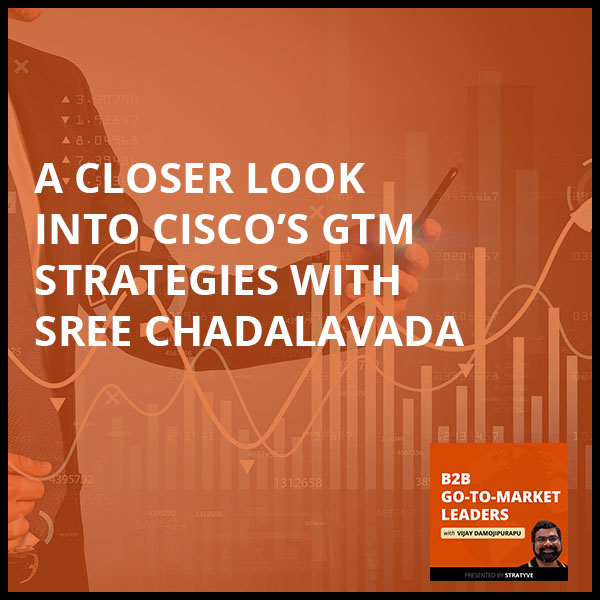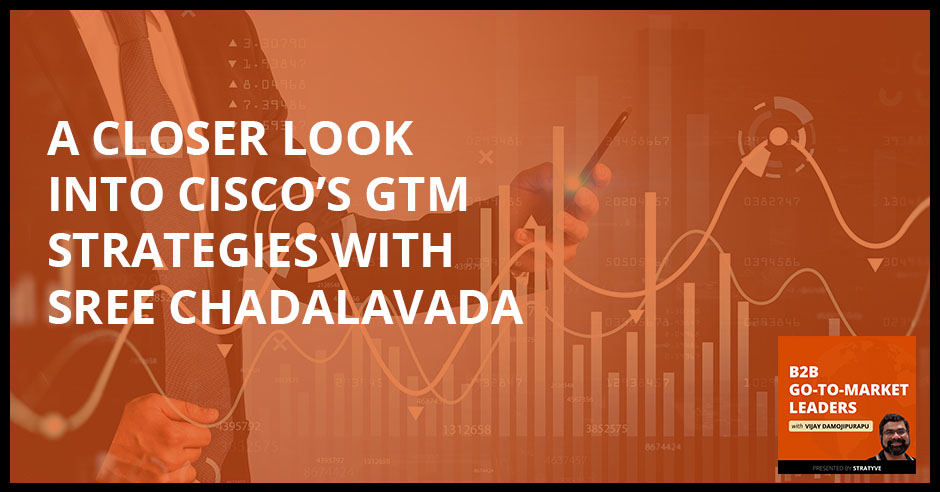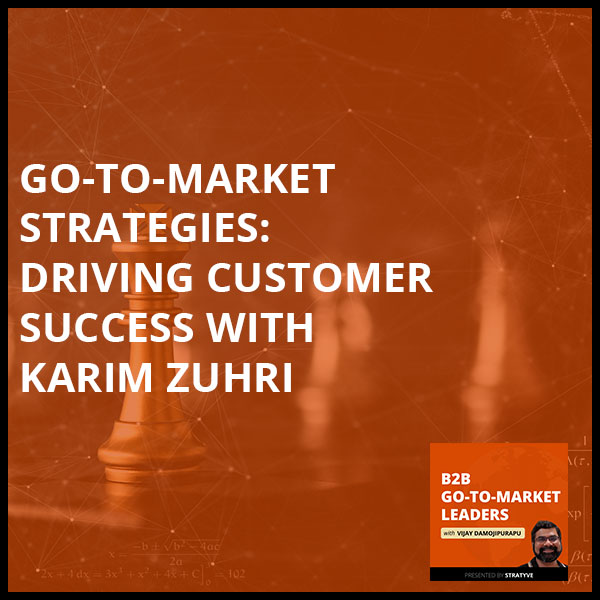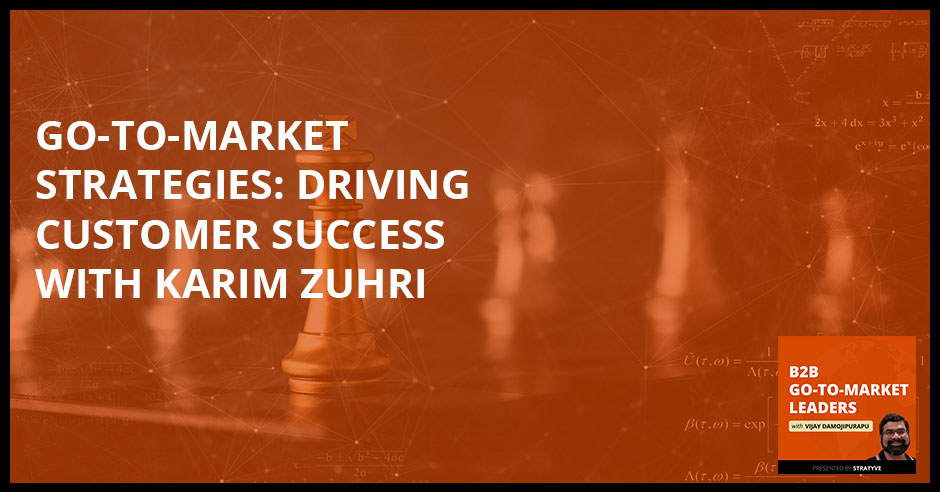

We are approaching a cloud-based world where everything is turning digital. How does the go-to-market strategy change? How do companies like Cisco adapt to new and different business strategies? Learn more about the process of GTM with the Head of GTM Strategies at Cisco, Sree Chadalavada. Before working with Cisco, Sree has worked with Gartner, a global research and advisory firm, in various roles for over 14 years. Now with Cisco, Sree is leading the GTM for their DNS Center. Catch Sree in this interview with your host, Vijay Damojipurapu, about how to market a subscription-based model and other business strategies. Discover why customer experience should come first when it comes to product strategy. Learn everything you need to know about GTM today!
—
Listen to the podcast here
A Closer Look Into Cisco’s GTM Strategies With Sree Chadalavada
I have with me, Sree, from Cisco and I’ll let him introduce himself. Sree, welcome to the show.
Thank you for inviting me. A little bit of introduction about myself. I have around twenty-plus years of experience in the industry. A lot of my experience comes from B2B space and mostly in high tech. I had roles anywhere from engineering to product management to GTM. Because of my several years of experience, I am now leading the GTM for DNA Center, which is one of the marquee software products that Cisco is selling to its customers. I’m looking forward to talking to you.
You are based in the Bay Area. We have almost subcontinental tropical weather. We are hitting 90 degrees here but both you and I grew up in India so we are very familiar. It’s not too much to complain about but we’re used to this weather.
I need to fix my cooling. I came from India in a tropical climate. The variation, how quickly we can go from cold to hot is something to get used to and I definitely need some home improvement going.
How would you define go-to-market?
In my mind, the go-to-market is a loaded term. In a simplistic view, I think about go-to-market as we have a business strategy. Oftentimes, I am taking more of a B2B large organizations viewpoint. If you have a large organization with a portfolio of products and services that you’re selling in the market, you start with a business strategy and then there is a product strategy. Those are two ends of the spectrum. GTM is what binds those two together and the whole purpose of GTM is to drive monetization and profitability within a particular organization.
Whenever you look at a business strategy of a long-term, sustainable company versus a product that generates revenue, you have a number of elements that need to work together. In addition to linking product strategy to business strategy, you need to look at sales, partner and customer success. All of those strategies need to come together and they all need to be driven with one beat. That’s what the GTM brings to the table. In my mind, the way I think about GTM is it’s a loaded term but the way I conduct it is it’s all about focus on revenues and profitability. It’s all about bringing disparate sets of functions together to work together to drive these revenue and profitability goals.
I would agree with almost all of what you mentioned. It does include working fruitfully and collaboratively across these functions such as product, marketing and sales, customer success and support teams as well. There is an end goal of driving revenue and profitability goals but there is one element, which I didn’t hear a lot from you and I want to push you on that. What is in it for the customer? Why should customers care? That’s a key point. A lot of the go-to-market teams are missing that. They’re internal-focused. This is something that I’ve seen often and to the detriment of the go-to-market execution capability. It is internal-driven but the emphasis should be on the market and the customers.
Whenever we think about a product strategy, the sustainability of a customer is driving value to the world and to the community at large. Maybe the reason why the customer was not included in my narrative is that I always believe in the fundamental nature of how you decompose a business strategy into a product strategy. Product strategy is all about the customer. We talk about product-market fit a lot. If you are developing a product that generates revenue then everything about that product should be about a customer. To your point, product, customer success, sales, partners, all of the people need to be talking to multiple sets of stakeholders but it all starts with customers. Definitely, that’s an omission that I’m glad that you corrected because it was built into the narrative.
A go-to-market has to link product strategy with business strategy. Share on XAll of the GTM functions are more like skin in my opinion. For every organization, everything happens. Business strategy is the brain that drives everything and all of these GTM functions drive everything but all the sensors need to be externally motivated to a particular customer. If you do not then there is so much of either productivity loss or you will not be sustainable. In the next five years, you will not have a place. Customer is always front and center. My boss always talks about customer excellence and customer-centricity. The way we share that across all of this is it starts with a product, the way we define a product and we continually iterate on the product-market fit. Everything in the GTM follows the product and the end product leads the way. All the GTM continually amplifies that particular aspect of it.
On a lighter note, how would your kids describe what you do at work?
I’m sure that many of us in the GTM has some identity crisis but I have a nonlinear career path. I’ll give a little bit of background and then I’ll explain what my kids talk about. I am a computer scientist. I was an engineer. I did graduate with a Computer Science major. I was a product manager and then moved to GTM consulting and then now I’m an operator of a product company. You’re going to look at my kids and it’s always interesting the way they think about it. When you ask those questions, it comes out.
My son feels like I am a consultant, an engineer or both. He’s confused. On one hand, I talk about the rigor, the hypothesis-driven problem solving and how you look at systems and decompose the problems is the consultant that I talk about. From an engineer’s standpoint, it’s all about the operation. What is the new value that we’re creating for the community and the world at large? There are both aspects. He’s confused, “Are you a consultant or engineer? You keep saying all those things. I don’t know.”
My daughter has this interesting way. I come from a consulting background. In a company like Cisco and I’m sure that any large company and even small companies, that happens. She talks about me having meetings about meetings because when you go to the executives, you first talk about, “Let’s develop a point of view,” and then you go to another person. It’s one of those things wherein a blue-collar to white-collar, everything that we do is communicating with people and driving change.
That’s what she thinks. She’s like, “You’re an advisor. I get it. From the nuts and bolts of it, everything that you do is meetings about meetings.” Hopefully, she will appreciate it one day. What she is looking at is anything that we do in consulting or GTM is about driving change, accountabilities and responsibilities. When you’re working with a lot of organizations, you’re working with a lot of people. It’s funny when you look at the kid’s views. One day, I go from a consultant to an engineer to developing slides. All those things go together.
That’s funny you say that. I can relate to a lot of those. I’ve also had several guests mentioned either the parents or the kids. Some of them correctly articulate what that guest was doing. It’s all about how do you articulate and tell about, “What do you do?” Whether you’re in a marketing role or a sales role or a product role, that’s a fun thing. It always brings out the lighter, the humor, the more personal and the humane side of things when it comes to a job.
At the end of the day, the core of it is we are all humans connecting to other humans. We miss that. We don’t think about it that way. When you talk to kids, that’s how they can think about it. The interactions that they are exposed to defines how they think about it.

Let’s switch gears. You talked about being in the consulting world and now you’re more in an organization like Cisco where you’re more responsible for the execution of the strategy, which you would typically build and then pass it over to your clients. Talk to us about your career evolution starting from your time at Gartner and then what you’re doing at Cisco now.
I did my MBA at Emory University. In around 2007, I graduated and then I joined Gartner as a senior consultant. The practice that I was part of was the GTM practice. A lot of people know that in Gartner, we have a lot of data. The reason Gartner exists is it senses the life of the customer. They track customer and market movements. We have all this data. Our GTM practice is all about taking the data and helping customers develop GTM strategies. It can be a GM who’s saying, “I need a product strategy. Can you help me build the next billion-dollar product on a market that I need to go after?” There are those problems.
There are engagements where, “We are going through this DevOps evolution. Can you help us? As a large $5 billion company, can you migrate to this?” Those are the things that I tried. I started with a senior consultant all the way to a managing partner. I also worked in a lot of the companies in the technology space and a lot of my clients are in the Bay Area. These are the people who created markets and it’s difficult to tell them what to do. They always feel like, “I know what I’m doing. I created the market so don’t tell me what you’re going to tell me.”
We went through this evolution as a managing partner. I ran a lot of these engagements, product strategies, market strategies and sales strategies for that matter. I got this rich experience of working with a lot of leaders that I’m sure are part of your show and you see them on a lot of these big stages. I had the privilege to be looking at them, working with them and helping them at Gartner. At some point, I said, “I have been giving a lot of advice. That’s great,” but then I said, “I need to do something. I need to execute what I’m telling.” It’s like eating your own dog food.
In consulting world, what you do is you give them good recommendations. Hopefully, those are the ones that you can bet on but you do not own the execution part of it. For fourteen years, I said, “I need to use a lot of what I did and need to be an operator,” as they call it in the industry. One of my clients said, “Sree, it looks like you have a lot of what I am looking for. I need somebody strong to drive GTM strategy for my organization.” That’s how I got into Cisco. In Cisco, what I do is taking all of that experience. I helped Cisco in developing a GTM strategy for this particular product and drive objectives.
One of the things that’s fascinating with Cisco is we’re phenomenal in terms of everything that we do in sales, marketing and partners from a hardware-centric standpoint. There’s nobody else who can do better than Cisco because we’re partner-centric and customer-centric. When we get to the subscription world, the rules of the game are different. This is a significant intent for every one of us to move forward. The privilege is good and bad. Everybody says it takes a village to move but in my role, I work with a lot of people like me in developing what the future view looks like.
I’m sure that you have all this news coming from Cisco saying that we’re at a $14 billion run rate from the software revenue standpoint. That is the promotion we’re doing. I’m helping with that transformation for the product DNA Center, which is within the wired and wireless networks on the campus. That is the product that I lead. I have been there for eight months. I built a lot of great relationships. There are a lot of things that I can learn and a lot of things that I can execute because, for several years, I’ve been talking a lot but now I know the things that make sense and don’t make sense.
That’s a fascinating career you had at Gartner joining as a senior consultant and growing up the ranks to a managing partner. Kudos and congratulations to you. That’s a fascinating rise in itself. It’s interesting that you switched and you intentionally wanted to go and move more into an operator role. Cisco itself is in a transformational phase because they’re switching or at least making the effort to move from a hardware-centric to more of a SaaS, revenue and subscription-based business.
Cisco has been doing this for a long time. If you look at the best in class SaaS companies, we want to be the best in class. When we look at a company that has been successful in the hardware-centric model, we have made a lot of progress but the progress continues to be there because we want to drive revenues and expand the scope of what we do. This role gives me a scope to help in that journey.
Go-to-market is more like the skin, while business strategies are the brains that drive everything. Share on XI’ve not had so many guests on my podcast where we had to dive in and talk about the shift from a one-time hardware sale to a software subscription model. Enlighten us and talk to us about the challenges. I can put myself in the shoe of an account executive selling routers and switches. It’s a long sales cycle. As an account executive, I hit my quota. Most often, I move on to other deals or other customers versus for subscription, it’s an entirely different mindset. How are you working with account teams and go-to-market teams at Cisco to make this transition happen?
It’s changing the way we do stuff. You need to have different kinds of relationships as you approach your customer. Let me take a step back. It is even a transformation from a customer standpoint. If you think about infrastructure, they have always bought appliances with a perpetual license. They would say, “Don’t come to me until five years is over.” Even the way they budget, it is for five-year subscription. That is how they budget CapEx dollars. Now, we’re looking at transformation at multiple stages. We’re saying, “How do we help the customer tell them that they cannot wait for five years?” That is the starting point for us.
We are going into a multi-cloud world. The pace of innovation is changing. We are educating our customers to say, “If you want to take on this multi-cloud world that the velocity of innovation is changing, you need to get the value incrementally quickly.” That is the reason we’re working with customers to enable them with the transformation. That is number one. We work with the salespeople and the way the salespeople do it is we have always said that selling an appliance is where our journey stops. Usually in a hardware mindset, you sell and you move on to the next deal.
We tell them they need to work with the customer success. If you think about the deal is over, the next step is, “Don’t go away because you have these long relationships. Please work with customer success to enable them.” We make a lot of promises during the sale cycle and oftentimes in a hardware-centric mindset, the partners will execute to get to some of those outcomes. Cisco is owning some of those outcomes. That is a big change for us.
If you go to a typical salesperson and if you say, “Did you sell?” “Yes. Amazing. I have done my job.” Now what we’re telling them is, “You’re not done. Please help us. Don’t go anywhere. We want you to work with the customers, your partners, customer success and drive outcomes.” There is a big difference between selling goods and services to selling outcomes. That’s what we’re working with account teams to slowly migrate to this mindset. A lot of account executives get it because they want customers to be successful. They have always relied on partners before and now they have to rely on partners but also Cisco to take that leap. That is the biggest change that we see. We made a lot of progress and we’re going to continue to make progress.
Change is hard, even though mentally I would like to create a new habit and sustain that new habit. I’m putting myself in the shoes of an account executive. There is an intent and a want versus making it happen over the course of days, months and years. It’s entirely two different things. There’s a combination of executive sponsorship and executive enforcement if you will but enforcement only gets you to so much. Is there a combination of that plus enablement piece, there is also the incentive-driven piece?
I come from the strategy world. I always think that there’s a mandate. The mandate is these greenfield initiatives cannot succeed. You need to have a mandate on a problem but the mandate needs to translate to what can be done in the next quarter. Oftentimes, you can think about it and say, “We want to be a subscription company.” For a large organization, it takes time. We need to take the mandate and chunk it down on what can you do in a quarter. When you think of quarter, there are three things that we’re always looking at. As an organization, is our operating model set up for success? That is number one. Are we having those relationships built between sales, customer success and partners? Can we continually iterate on the operating model?
The second is incentives. Are we making incentives and KPIs that integrate on a collective customer outcomes mindset? The third is we take feedback oftentimes and the mandate only goes so far because there is reality, the ground. The last thing that you want is to disenfranchise anybody who was significantly successful and lose them in this transformation. We are taking enormous amounts of feedback from the field and continually iterating this particular model. We have three different processes. One is a mandate. The second is the operating model. Three is the incentive structure.

Finally, it’s feedback. Always focus on the feedback. Always build the change because if you have the influencers, you need to be looking at the influences who are working with you and enabling transformation. I come from a lot of change management and that enables me to talk about it. I always look at the culture as a complex entity. We talk about culture as a nebulous term. For me, it’s the incentives, rituals and those kinds of things. I look at it systematically and say, “What can we do without breaking ourselves?” We are disciplined in the way we execute the techniques.
You mentioned how you measure and there’s also the feedback aspect. Let’s talk about if you can to the extent that you can share in a public forum, can you talk about the KPIs and how you set goals into ensuring that the change is happening?
I don’t think some of the frameworks are any different from a strategy standpoint. The viewers need to think, “What does the future state look like?” You always need to have a clear view of where we want to be from a metric standpoint. Almost always, we know this. We want better revenues, a better renewal rate and a customer experience. Those are the three. At the end of the day, any business will know about those three for me.
We look at what the future state is. We cannot get there unless we cut it down to every quarter. This is what we need to achieve and then cross those three terms. We talk about revenue goals, renewal rates and customer experience. Every quarter, we’re iterating through those goals and building new initiatives. We have a governing model that says, “We’re all going to work together for this transformation. We have partnerships.” I’m part of the product organization. There is a product, relationships, there’s sales, customer success and partners as well as marketing, product and technical marketing.
All of us work together to say, “Can we achieve that target and continually grow?” It’s like a flywheel analogy in Good to Great. There is this notion that coming from consulting it is this one big wave that carries everything. It’s never that. It’s like in every small incremental thing that you do and continually build the momentum and kill the initiatives that are not working. Amplify and double down what is working and keep moving. This operator role is interesting but the most important place where the operator role falls apart is when you don’t have a clear future state. If you do not have a clear future state of what I want to be when I grow up, that is when the operator role can be nebulous. I am going to do all kinds of things that don’t matter but if I have a clear view of where we are headed, it’s about execution. You’re continually working at it, spreading it and making progress at the business.
Let’s get even more detailed and specific here. When it comes to the second half a year and you’re managing the go-to-market evolution and the change for Cisco DNA products, services, software modules and subscription services as well. What are your focus areas for the second half for Cisco DNA?
For us, there are three things. Engagement from the field is the most important thing for us. I’m part of a central organization and Cisco is massive. What we’re trying to do for us is execution happens in a decentralized fashion in large organizations because you can only develop strategy and you can only have the central organizations that can enable the strategy. There are three waves of work that we’re looking at for the next job. We feel like we have a decent strategy. The next wave is working with the field to get feedback and improve the strategy. That is what we are focused on. These three are concentric circles. They keep moving. We have a strategy and now we are working in the middle field to make sure that they know the strategy that is help coming and we are seeking their help on how to transform.
The third element of it is at the end of the day, it’s accounts. It is this filed down list. You need to look at what is happening with this account versus with that account. There are three concentric circles that are happening for us. The second half is all about getting the field and getting to the part of the marquee accounts where we can ring-fence and do cohort analysis. Can we take small set customers and continually build these practices? That’s where we’re going to be.
Do you own a budget for your role specifically?
You need to find humane things when it comes to your job. At the end of the day, we are all just humans connecting to other humans. Share on XMy boss owns a budget but he’s pretty flexible with the budget because it’s one of the key parts of the business.
If you or your boss were to get an additional 5-figure, 6-figure or maybe in the case of Cisco it’s an additional seven-figure number for the year going or even going into the following year. What are the key areas that you would invest in?
Data is everything for us. The way we are operating and every company is becoming a digital company for us. There are a number of initiatives going on but I can always ask more to accelerate these initiatives. That’s the way I think of it. You should not take it as we’re not doing it. Maybe others feel like, “If I want to go faster, I want something that gets me there. It’s about having the tools that can help us.” There are two aspects of the way I think about it. In GTM, everything is as good as your data, the systems and the GTM processes that you have.
For me, data is the most important thing. How do I build it on the fingertips? For me and the people who are executing these strategies, do they have the dashboards? Not a single dashboard but it should be where they are looking at data. For example, if you are on Salesforce, do I have the right metrics and the right data for a sales executive to take action? Those are the places where I would be spending a lot of time. For me, I need to have the data and the dashboards to be able to say, “Are we going in the right direction? Can I course-correct very quickly?” In the same vein, there are so many people like me who are trying to write and improve their business performance. Can I help them with those kinds of systems so they can make those decisions? We are blessed in this way.
I come from a strategy background. I don’t need somebody else telling me what the strategy should be because, at the end of the day, many people have those ideas. For me, the biggest thing is if I’m operating faster, I do not want systems to be a bottleneck. I need to move away from systems being a bottleneck to the change management and getting to the customer outcomes. That’s where I would be focusing if I have more budget.
You mentioned data and tech stack. One element of the tech stack, which is CRM, in this case, Salesforce. Is it more of how do you refine and fine-tune your Salesforce to create the right dashboards or is it more of an additional market or sales tech stack and making those work? Is it something like a BI, a Tableau?
We start with BI Tableau. That’s where I think about it. These systems have been there for a long time. You know how a lot of these organizations are. You start with a Tableau. You figure out if it’s helping you to make the decisions and I’m sure that data is not always perfect so you learn a lot and you shift to continually improving the data. That’s how I always think about it. If you have all of these dashboards and they don’t mean anything and the data is not complete, I cannot make decisions. The way I want to do it is, it’s always that there is this Deming’s quality improvement cycle. You need to know what you’re measuring. I have the visibility to what I’m measuring and can I take the data to continually improve the process but also improve my data hygiene across the board and the processes that build the data. In my mind, if we’re on a journey but I want to start with the dashboards but then I go back to how to improve the data consistency and reliability.
What are the top couple of topics or areas that are top of mind for you? How do you learn or keep up to date on those topics? You mentioned go-to-market and strategy. Are there topics underneath or something else?

I read this only a couple of years back the way Amazon does it right. I’m looking at that. Usually, there is a view that I have seen and a lot of that is real with many of the companies. There is a product strategy and there is a GTM strategy. Those are two separate strategies and usually they are decoupled because we have the legacy and heritage of how we have done. What I’m seeing is a convergence of GTM and not convergence. It’s tighter alignment and convergence. What I mean by that is let us take a scenario where your video is in your own dashboard using the product. Can I manage my licenses in it? Can I make my purchases? It’s those things there are significant ways that we can improve the customer experience and integrate the GTM motions into the product motions. That is fascinating for me and that is where I’m spending a lot of time trying to understand how do I continually build digital assets to try with GTM.
Second, how do we continually push GTM and convert GTM with the product? If I can let the customer do all the purchases here, let the customer do the free trials on the product and push it to this. There are so many ways you can get to simplify the customer experience and not having to go through this, “Go to this system to do the sales.” “Go to this system to do the partner.” “Go to this system to do all of those things.” Rather than that, if you are going to keep the customer in view, then telling the customer to say, “I am simplifying everything.” That is where I’m spending a lot of time. We are all going to do our own research. There are some companies that are doing a better job than we are and it’s always a fascinating aspect for me to learn from those companies.
Something that I want to highlight and this is what I advise my clients. A bit about me, my company, Stratyve. We advise B2B SaaS companies small, medium and large, around go-to-market clarity and execution. One of the pieces that I’m enforcing into whenever I meet either a marketing leader, a product leader or even a revenue leader. I always enforce and emphasize this aspect of content being the currency. You mentioned digital assets on how I see it and what I refer to it as content. Think of it this way. When you talk about a software product, your code is your currency for a software product. Similarly, for go-to-market, I would say its content. Content is the key.
From there, you go into, “What does it mean when I’m educating or enabling my salespeople? What does it mean when I’m talking about the customer moving him or her along this journey or the path, the transformation?” That’s what I keep coming back to is content. I’m also enforcing and building what I call the Content To Revenue Manifesto. It is because similar to software code as a software engineer, I can write code but that may or may not create an impact. Similarly, I can create the digital assets and the content but that may or may not tie very well to driving revenue, renewals, a better experience and a subscription model. I’m enforcing and talking about this Content To Revenue Manifesto. I want to get your thoughts. You mentioned digital assets but I’d be happy to sit down with you or your team around how you can create, invest and get better returns when it comes to creating these digital assets.
I’d be happy to do that. We are all about video and digital assets to your client. You started with, “Why did you not talk about the customer?” For me, it’s about a 360-degree view of the customer, anywhere from awareness to loyalty and the whole thing. We had this framework when I was in Gartner called Content and Context. Look at the customer and say, “At what context, does the customer look for what?” “If he’s looking at what, are we going to the right water coolers?” “Where are they going? Where do we need to present our content so customers do not have to look for the content?” With all the SEOs and everything, we can do it. You’re absolutely right. I will be happy to have a conversation and see how we can collaborate.
If you were to look at your peers or your bosses from either your current role or even previous roles, who would you call out, give a shout out to when it comes to them having an influence and how they shape your thinking as well your career growth path?
There are two classes. You have two specific questions. One is who is the biggest influence on how I live and how I conducted my professional life? Who are the co-workers that you want to emulate? This changes every year. You’re always learning and you’re always looking at what it is. A lot of my influences come from the counterculture. They are the people that really helped me. The three people I can say and I’m sure that many of your audience knows them. Nassim Taleb is one of the guys.
The quote he had and maybe the reason I moved from consulting to the operating role is a lot of what we learned from either consulting, theory or even in education. All that we do is tell the birds how to fly. He has this piece that says, “The real knowledge that you learn doesn’t come from books. The real knowledge comes from tinkering, experimenting, learning and getting feedback loop.” That was phenomenal. Nassim Taleb had a significant impact. Antifragile and Skin in the Game is another book. These are thought-provoking books that ask you to change and say, “As a person, what impact can you create?”
The second person, this is a cop-out as everybody would say it but Steve Jobs is another influence. I read and study a lot about strategy and what companies are. If you look at Peter Drucker as being the Father of Modern Philosophy, I would consider Steve Jobs as the Father of Technology Management Philosophy. Also, customer experience and he talks about how to say no. When you’re developing a strategy, do not ask for everything.
If anybody says that they know better than what you know, they don't know. Share on XAfter many years, we are starting to get that into the mainstream. He has been far ahead and I always go back to his videos and say, “What am I doing right or wrong?” The third one is Phil Knight. I was fortunate I read the book. It was not something that I would read from the get-go. For a lot of people who don’t know, Phil Knight is the Founder of Nike. One of the one thing that I realized and oftentimes I come from India and there has always been this quintessential view of the leader. This is charismatic, they go and they can rile up all the audience.
These are the kinds of people and you always look at them and say, “I can never be that way.” You always have this perspective. When you read Phil Knight and the way they build the company, it is about a lot of people who had so many problems and he says, “We would never be successful if we all went our own way but if we will focus on a mission and with a level of conviction, you can create a company that is long sustainable.” I can go out and say these are the people that change everything.
At least in my career, Charles Chun who lives in Japan, in Gartner Consulting. He always told me that with critical thinking, you always need to wear your customers’ shoes. You need to really solve the problem. He never gave up until the last minute of an executive conversation. He’s like, “I’m getting the slide of it.” The more you think about the problem, the more you live there, that rigor, I got it from Charles. My manager is similar in that way because these are the people who never give up. These are the people who call themselves academic operatives. They have a mission to continually improve and create a framework on it but they are rigorous in the execution. Those are the people that have had a lot of influence. We live in a world that’s continually changing. Come back in a few years and I will say it’s Elon Musk. We get better.
You would add Elon Musk maybe at some point in time once you know his sticking philosophy. Going back to your point, I agree with Steve Jobs and others. I also want to call out specifically, Phil Knight. I’m reading his book, Shoe Dog. I’m in the early section where he talks about where he tells father, “I want to go on a world trip. I don’t know what I’m going to do with my career after graduating from Stanford with an MBA degree. I don’t know what I want to do.” Somehow, he wants to do something around bringing better shoes and selling better shows in America.
He goes to Japan and even then, he doesn’t know what he’s going to do but he’s clear on the mission. Going back to your point, it’s very mission-centric and there’s almost a fake it until you make it but in a good way. It’s not in a false ego-sense. It’s about, “I’m mission-centric. I need to partner with these Japanese shoemakers and manufacturers. It’s all about telling how I bring those shoes and help them increase their sales. At the end of the day, how am I getting better shoes for the American consumer?”
That is the counterculture. That’s what I keep talking about. We say the counterculture is the attitude that they take is, everybody who says that they know better than what you know, they don’t know. That is the fundamental way that a lot of these people think. It’s like, “If somebody keeps telling me that I’m on the wrong path or I’m not doing the right things,” but very quickly, you’ll realize that if you’re going steadfast, all the people and everything that people tell you that you don’t know and don’t do it, they don’t know. It’s interesting the way they came to solve the problems.
It comes back to the mission-centric and that’s what keeps them going. Along the way, they figure out the path and the solution it comes. It’s not that they don’t from the get-go.
They gravitate towards building the team that is around them and that is complementing. That’s the fascinating part of this.
One final question to you, Sree. If you were to turn back time and go back to day one of your go-to-market careers, maybe it’s that time when you joined Gartner as a senior consultant or something else. If you were to turn back time, what advice would you give to your younger self?

Let me start with the first and foremost, while you are uncomfortable, always try to surround yourself with the best people, the people that you can learn from. The people who are motivating you to do your best and you can learn from it even if it’s painful. That is the first thing that I would say. The second thing that I would say is any endeavor that you are doing, you need to be humble to take the feedback and learn from the circumstances.
Any belief system that you develop, you need to work with people and how to change people. Those are the two things that I would say. One, always surround yourself with smart people. Whenever you’re trying to impact a change, be patient, understand why people don’t agree with you or don’t believe you and see what you can change in their belief system. It is not because they don’t like you. It is not because they hate you. It is because their belief system is completely different than your belief system. Be patient to start with what their belief system is and work backward to your belief system. If you don’t do that, you will not be successful. Those are the two things that I would like to say. Be patient with people who are impatient and learn but be patient with people who do not want to change and be patient to bring them along. Those are the two things that I would say to myself.
To your second point, talking about understanding people, learning and helping them see or change their belief system. It comes down to this one line, which really stuck with me, “Don’t try to change the other person but try to change your perspective of the other person.”
That’s what I keep telling myself. Oftentimes that goes back to your mission and where they come. When you think about what your mission is, you will find a way and that is where if you want to be a change agent, to that point. The perspectives, you need to be a lot more human-centric than say, “Everybody else did it. I’m going to do it and you need to follow it.” Nobody follows at this point. You need to convince them to follow. You need to be around the people who can follow.
Where can people learn more about you? If you want to share any final words with the readers, what would that be?
I’m always on LinkedIn. If you want to learn and collaborate, I’m always learning so I can tell you what I know but I’m sure that in the conversation, I’m going to learn from you. You can always find me on LinkedIn. If you want to reach out, please reach out. A lot of what I do at my work, you’ll see on my LinkedIn page. I’m definitely looking forward to hearing from you and working with you, Vijay, as well as hearing from your audience.
Thank you so much. To all the readers, do drop me a note on LinkedIn and mention that one takeaway that you got from our conversation. Post it on LinkedIn and let me and Sree know what that is. Thank you for your time, Sree. It’s been a wonderful conversation and I’ll be always cheering for you and your team.
Thanks a lot, Vijay. I’m looking forward to working with you again. Bye.
Important Links
- Cisco
- Gartner
- Good to Great
- Antifragile
- Skin in the Game
- Shoe Dog
- LinkedIn – Sree Chadalavada
- LinkedIn – Vijay Damojipurapu
About Sree Chadalavada
 Product strategy & marketing technology executive with over 20+ years of technology experience in infrastructure software and hardware technology markets. Cross-cultural experience in the United States, Europe, Japan, South Korea and India. Thought leadership endeavors include published Gartner Research.
Product strategy & marketing technology executive with over 20+ years of technology experience in infrastructure software and hardware technology markets. Cross-cultural experience in the United States, Europe, Japan, South Korea and India. Thought leadership endeavors include published Gartner Research.
-Execute product strategy, product management lifecycle, engagements for GMs, VP of Strategy and CMO
-Extensive experience working with global ISV market leaders and GMs with $1B+ product portfolios and driving top-line revenue growth by executing product strategy, product management lifecycle support and marketing strategy development and execution.
-Deep understanding of enterprise customer buyer/persona mission-critical priorities, buying behaviors and digital investment strategies; Deep specialization in AI, DevSecOps, AIOps & Edge Computing domains
-Worked extensively with clients and managed delivery teams across multiple geos – United States, Europe, Japan, South Korea and India
-Office lead for San Francisco Bay Area office with ~80 associates reporting to this office
Prior to Gartner, Sree worked in various leadership roles in telecom, technology consulting and start-up-related companies. At DXC and MCI, Sree held various leadership roles focused on Product Management, Corporate Strategy and Innovation and Solutions Marketing.
Sree is currently working with 3 – 5 startups in advisory capacity in fine-tuning the product strategy to achieve product/market fit. In addition, he is an advisor and co-chair for TiE Young Entrepreneurs program focused on fostering future generations of entrepreneurs by teaching high school students and mentoring college students the rewards and challenges of becoming an entrepreneur.
Sree earned his MBA with Outstanding Academic Achievement Award in Decision Information Analysis from the Goizeuta Business School, Emory University.
Functional specialties include: Product management, Product Strategy & Execution, Business Strategy & Execution, Enterprise Customer adoption, Sales Operations
Market focus include: AI, DevSecOps, AIOps & Edge Computing domains
Love the show? Subscribe, rate, review, and share! http://stratyve.com/






 I help companies scale up and grow into unicorns. I build teams of teams.
I help companies scale up and grow into unicorns. I build teams of teams.